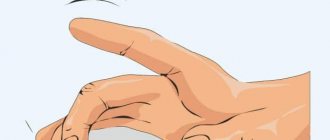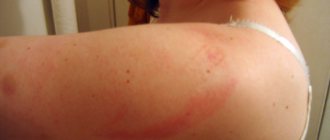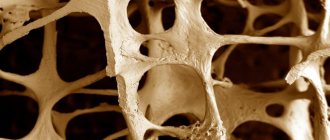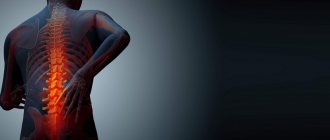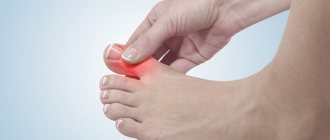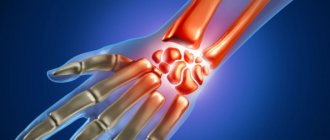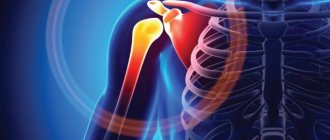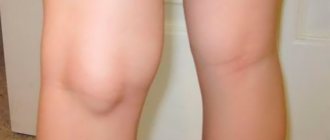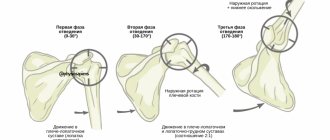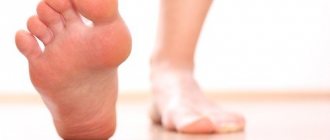A shoulder bruise is most often caused by an unsuccessful landing during a fall or a strong blow from a hard object. You can also hurt your shoulder if you use sports equipment incorrectly in the gym.
A shoulder bruise most often occurs due to a fall, a blow, or while playing sports.
The signs by which such an injury can be recognized are severe pain in the shoulder at rest, which intensifies with sudden movements of the body or the affected upper limb.
Immediately after a fall or blow, it is better to seek medical help, since it is important to differentiate a bruised shoulder from a bruised shoulder joint, as well as a dislocation, fracture and other injuries to soft or bone tissue.
Incorrect treatment can lead to the development of complications of varying severity and increase the recovery period of the victim, so even in mild cases it is better to consult a doctor.
Symptoms of a shoulder injury
The main manifestations of a bruise are pain in the injured area, present in a calm state and intensifying with sudden movements. In severe cases, swelling, swelling and hematomas may occur.
The main symptom of a bruise is pain
A bruise in the shoulder area is distinguished from a bruise of the shoulder joint. In the first case, only soft tissues are injured; joint dysfunction is not observed. The second is obtained through direct impact on the joint, for example, when falling on an outstretched arm.
In both cases, the treatment is not particularly different, but the sensation of a shoulder joint injury may be accompanied by more intense pain.
Based on the severity of the manifestations, the following degrees of severity of bruises are conventionally distinguished:
| Severity | Manifestations |
| First | Light bruises, abrasions and scratches, minor discomfort when moving your arm. There is no need for specialized treatment, symptoms disappear on average within 3–4 days |
| Second | Hematomas, severe pain in the damaged area, aggravated by movement, swelling may appear and body temperature may rise |
| Third | In addition to severe pain, hematomas are observed, dislocation of the shoulder joint, damage to tendons and ligaments is possible |
| Fourth | Severe swelling of the injured area, which can spread to surrounding tissues, complete lack of sensation in the shoulder |
Causes of injury
Any excessive load can cause pain in the shoulder joint, which is one of the largest in the human body. The anatomical structure of the shoulder is complex and capable of performing movements in several axes at once, which increases the risk of developing various pathologies in it. Therefore, a bruise of the shoulder joint can have quite serious consequences.
The most unique, yet complex joint in the human body is the shoulder joint. It performs many different movements because the shoulder joint is formed by the connection of bones, muscles and tendons. It takes part in absolutely all movements of the hand and is able to withstand very heavy loads. Therefore, the shoulder is vulnerable to various pathologies, since any injury to the shoulder due to a fall can lead to serious consequences.
You can get such damage at the workplace, especially if it is some kind of production, at home, during sports training, on the playground or on vacation. In this case, both the joint itself and nearby tissues can be injured. Typically the main cause of a severe shoulder injury is:
- a strong beat;
- compression of the shoulder joint;
- careless fall.
An injury to the shoulder joint, after which the arm often cannot be raised, is a common occurrence for young people who actively improve their health through regular exercise. Sports injuries subsequently become the reason why the shoulder joint hurts constantly, and sometimes even at rest.
Such injuries are typical for training in many sports when practicing certain strikes and techniques:
- hockey with a puck or ball;
- golf;
- tennis;
- Weightlifting;
- body-building;
- gymnastics;
- basketball;
- volleyball;
- skiing;
- figure skating.
Any throwing of the ball, practice of hitting the ball with a racket, exercise with weights to develop muscles, or falling during sparring can result in a shoulder bruise that requires treatment. The shoulder joint often begins to become very painful because a fall or blow can cause damage not only to soft tissue, but also to tendons and muscles. Usually, more than just one structure is injured.
A severe bruise of the shoulder, in which the arm cannot be raised, can occur due to a sprain or tear:
- muscle tissue surrounding the shoulder joint;
- synovial bursa;
- tendons;
- joint capsule.
Sometimes a shoulder injury from a fall can result in damage to the bone structures. This injury most often occurs during a fall from a great height or during a transport accident. Lacerations and fractures that accompany a bruise can cause arthrosis of the shoulder joint in the future. In order to avoid pain and contracture that appears after an injury, attention should be paid to comprehensive treatment.
In order to exclude a crack, dislocation or fracture, it is recommended to consult a traumatologist. A specialist will examine the site of the injury and explain how to treat a severe shoulder injury. Self-medication is very dangerous, as it can cause serious consequences. Only a doctor can assess the scale and complexity of the injury and suggest a treatment method for the bruise.
First aid
The first thing you should do if you bruise your shoulder due to a fall or as a result of an impact is to examine the injured arm. If abrasions and scratches are found, they should be quickly treated with an antiseptic solution to avoid further infection.
Next, you need to try moving your fingers, hand and arm. If physical activity causes pain, but remains possible, you can fix your arm with a scarf, towel, scarf, etc. To do this, you need to bend your arm at a right angle at the elbow and secure it in this position with improvised material on your neck.
If the bruised area is very painful, non-steroidal painkillers can be used - Ketorolac, Nimesulide and others. In the first 6–12 hours after a fall, it is recommended to apply cold compresses to the injury site.
It is important for the victim, even with a minor injury, to seek advice from the emergency room in the future. In severe cases, first aid should be provided by a qualified physician.
Recovery period after injury
Within a couple of days after the injury, you can start doing massage. Such manipulations will help to significantly reduce recovery time. It is recommended to start the massage with a healthy part of the body so that the patient gradually gets used to the massage effects. If the victim has a bruise on the right forearm, then you should start with the left shoulder, gradually moving to the injured joint.
In the same way, if you bruise your left shoulder joint, you need to start with a healthy part of the body. First of all, massage the area above the injured area to ensure the outflow of lymph and blood. It is enough to do a therapeutic massage twice a day for a few minutes. It is recommended to alternate stroking movements with rubbing movements.
As soon as the pain decreases and there is no fever, you can begin to massage the injury site directly. At this stage, in addition to stroking and rubbing, kneading is added. With each procedure, it is necessary to increase the duration and intensity of the massage. During the rehabilitation period, the patient is also recommended to engage in therapeutic exercises, which will improve the general condition of the victim and restore elasticity and tone to the ligaments and muscles.
A set of exercises after a shoulder injury due to a fall should be compiled based on the symptoms on an individual basis. If there are no dangerous complications, then classes can begin on the second day after the injury. The main emphasis is on abducting the injured arm and moving the shoulder.
While performing the exercises, you should try to keep the muscles in the shoulder area relaxed. Only in this case can you get a good result. Do not immediately load the sore joint. At the initial stage, all exercises should be general tonic. The complex should include the following movements:
- clenching and unclenching fingers;
- moving the brush in a circle;
- raising the shoulder joints;
- shoulder abduction and return;
- movement of the injured limb in all directions.
It will be possible to fully raise the injured arm in the second stage, but the healthy limb should be used. When the patient begins to recover, it will be possible to use various devices, for example, dumbbells. Serious exercise is allowed only at the last stage of recovery.
You should consult with your doctor before fully resuming your normal daily activities. A traumatologist will tell you how long a shoulder bruise can hurt, and when it’s time to put stress on the affected joint.
Diagnostics
During diagnosis, an initial examination of the patient is carried out and symptoms are recorded. Also at this stage, the victim is questioned in detail about the incident that resulted in the injury, and it is noted whether he has any concomitant pathologies.
To avoid the development of complications, it is important to seek medical help in a timely manner.
Next, an external examination is carried out with palpation of the injured area - checking for bone fragments, joint deformation, bruises, scratches or loss of sensitivity.
If severe damage to muscles, joints, bones or ligaments is suspected, the patient is referred for additional instrumental studies, which include:
- Magnetic resonance imaging;
- CT scan;
- ultrasonography;
- angiography;
- arthroscopy;
- arthrography;
- X-ray.
If a fracture is suspected, an x-ray is prescribed
In rare cases, when there is an unsatisfactory general condition of the victim, nervous tension, or there is a suspicion of infection of the wound cavity with further infection of the blood, joints, etc., a referral is given for laboratory tests. Usually a coagulogram, biochemical and clinical blood test are performed.
Treatment of a shoulder injury
In mild cases, seeking medical help is not necessary. It is possible to carry out symptomatic therapy at home.
If, three days after the injury, the injury site continues to ache or the pain intensifies, it is recommended to consult a traumatologist or surgeon.
Conservative therapy
On the first day after a bruise, it is advisable to use cold compresses, for which ice cubes wrapped in cloth can be used. On average, you can apply cold to the shoulder or shoulder blade area for no more than 10–15 minutes.
List of medications that can be prescribed for bruises:
- Streptocide, Chlorhexidine, Rescuer and other antiseptics: used to treat open wounds, scratches and abrasions;
- Celebrex, Movalis, Nise and other non-steroidal anti-inflammatory drugs: used for 3-5 days to relieve inflammation and swelling;
- Novocaine solution: injected into the affected joint area in case of severe pain;
- Diphenhydramine, Ketanov, Analgin and other analgesics: prescribed for pain relief;
- Voltaren, Diklak gel, Dolobene gel, Finalgon, Troxevasin: help effectively relieve the inflammatory process.
It is important to take into account that it is better to use any drugs as prescribed by a doctor in accordance with the treatment regimen prescribed by him.
The victim is advised to remain in bed in the first days after a fall or blow. The injured arm, forearm and entire shoulder joint should be fixed with an elastic bandage to restore normal blood circulation.
In cases where, 2-3 days after the injury, there is an accumulation of blood and fluid in the joint, a puncture may be prescribed. If the hematoma continues to grow, the patient is given drainage.
Physiotherapy
Physiotherapeutic treatment methods can be used for bruises of the shoulder joint 5–7 days after the injury. The following procedures are considered the most effective in such cases:
- electrical stimulation;
- paraffin applications;
- electrophoresis;
- magnetotherapy.
In some cases, physical therapy is indicated
After complete restoration of the joint and the disappearance of acute pain, the victim may be prescribed a massage of the injured area. This procedure is carried out by rubbing and stroking the skin towards the venous outflow. The massage is done for 20 minutes (at least), it has a positive effect on blood circulation and tone of damaged muscles.
ethnoscience
It is better to cure the consequences of a bruise using traditional methods at home with the permission of the attending physician.
Burdock root ointment
Used for compresses and application to the area of injury. To do this, wash the burdock roots thoroughly and then wipe dry with a towel. The prepared raw materials are placed in a blender and crushed or grated on a fine grater. The resulting slurry is poured with 1 glass of olive or sunflower oil and mixed thoroughly.
The mixture is placed in a glass container, infused for one day, after which it is heated over low heat for 15 minutes, avoiding boiling. The resulting ointment is filtered and, when finished, rubbed into the injured area or used for compresses. The product should be stored in the refrigerator.
Vinegar-based compress
The product has an anti-inflammatory effect. To prepare it, 0.5 liters of water are mixed with 1 tablespoon of 9% vinegar. A natural cloth or a piece of gauze is moistened in the resulting solution, which should then be applied to the area of the bruise.
How is it treated?
Treatment of a bruised shoulder joint depends on the presence or absence of associated complications and the severity of the injury. First of all, the injured shoulder joint requires rest. Therefore, the doctor applies a fixing bandage, which is recommended to be worn for 2 weeks.
The patient is advised to refrain from physical activity, sudden movements, and not lift heavy objects. To reduce pain and relieve swelling, cold compresses are used in the first week of treatment. It is recommended to apply them after every 5 hours. The recommended exposure time is half an hour.
Treatment at home involves limiting physical activity, using local painkillers, decongestants (ointments, gels), which are applied to the damaged area 2-3 times a day. Such procedures will improve blood circulation and microcirculation, and relieve inflammatory manifestations.
The patient may also be prescribed a course of vitamin therapy and anti-inflammatory drugs (Celebrex, Nise), which should be taken for a week.
Possible complications
Failure to provide medical care to a victim in a timely manner, especially in cases of severe injuries, may cause the following complications:
- hemarthrosis;
- traumatic bursitis;
- post-traumatic arthrosis;
- subcutaneous hematoma;
- suppuration of a wound received from a shoulder injury;
- synovitis;
- humeroscapular periarthrosis (periarthritis).
Elderly patients need special attention, which is associated with a high likelihood of complications.
A possible complication of the lack of adequate treatment for a bruise in elderly patients is often impaired joint mobility associated with tendon damage.
In such cases, massage and physiotherapy methods are recommended to restore the shoulder joint. It is important to remember that due to the high risk of osteoporosis, elderly patients who have sustained a shoulder injury require close medical monitoring.
Complications of bruises of the upper shoulder girdle
- Hemarthrosis is a reactive filling of the joint cavity with blood due to rupture of small periarticular vessels;
- Traumatic bursitis is a promising lifelong complication that limits joint mobility;
- Periarthrosis is a pathological growth of periarticular structures in advanced injuries that are not observed by a traumatologist;
- Synovitis is excessive filling of the joint capsule with the synovial component, leading to painful swelling. Occurs immediately after a bruise or in the first hours;
- Rupture of ligaments or nerves - urgent surgical intervention is required;
- Traumatic myositis is acute muscle pain caused by significant muscle damage.
Correct provision of first aid and subsequent medical supervision to the victim helps to avoid serious complications. To summarize briefly, let's summarize the algorithm of actions. So…
